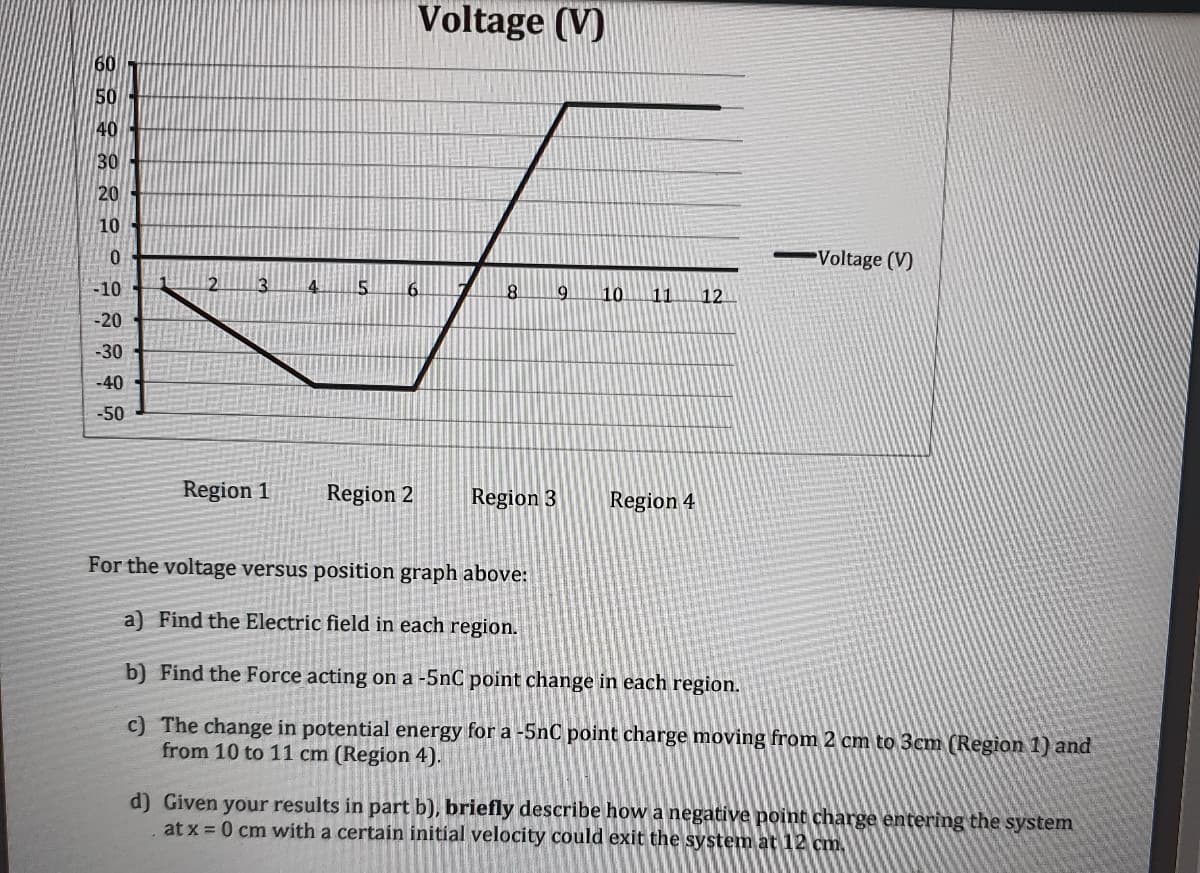Voltage (V) 60 50 40 30 20 10 Voltage (V) -10 8. 19 10 11 12 -20 -30 -40 -50 Region 1 Region 2 Region 3 Region 4 For the voltage versus position graph above: a) Find the Electric field in each region. b) Find the Force acting on a -5nC point change in each region. c) The change in potential energy for a -5nC point charge moving from 2 cm to 3cm (Region 1) and from 10 to 11 cm (Region 4). d) Given your results in part b), briefly describe how a negative point charge entering the system at x = 0 cm with a certain initíal velocity could exit the system at 12 cm,
Voltage (V) 60 50 40 30 20 10 Voltage (V) -10 8. 19 10 11 12 -20 -30 -40 -50 Region 1 Region 2 Region 3 Region 4 For the voltage versus position graph above: a) Find the Electric field in each region. b) Find the Force acting on a -5nC point change in each region. c) The change in potential energy for a -5nC point charge moving from 2 cm to 3cm (Region 1) and from 10 to 11 cm (Region 4). d) Given your results in part b), briefly describe how a negative point charge entering the system at x = 0 cm with a certain initíal velocity could exit the system at 12 cm,
Physics for Scientists and Engineers: Foundations and Connections
1st Edition
ISBN:9781133939146
Author:Katz, Debora M.
Publisher:Katz, Debora M.
Chapter27: Capacitors And Batteries
Section: Chapter Questions
Problem 20PQ
Related questions
Concept explainers
Dielectric Constant Of Water
Water constitutes about 70% of earth. Some important distinguishing properties of water are high molar concentration, small dissociation constant and high dielectric constant.
Electrostatic Potential and Capacitance
An electrostatic force is a force caused by stationary electric charges /fields. The electrostatic force is caused by the transfer of electrons in conducting materials. Coulomb’s law determines the amount of force between two stationary, charged particles. The electric force is the force which acts between two stationary charges. It is also called Coulomb force.
Question

Transcribed Image Text:Voltage (V)
50
40
30
20 -
10
Voltage (V)
-10
2.
3.
4
11
1.
12
-20
-30
-40
-50
Region 1
Region 2
Region 3
Region 4
For the voltage versus position graph above:
a) Find the Electric field in each region.
b) Find the Force acting on a -5nC point change in each region.
c) The change in potential energy for a -5nC point charge moving from 2 cm to 3cm (Region 1) and
from 10 to 11 cm (Region 4).
d) Given your results in part b), briefly describe how a negative point charge entering the system
at x = 0 cm with a certain initial velocity could exit the system at 12 cm.
Expert Solution
This question has been solved!
Explore an expertly crafted, step-by-step solution for a thorough understanding of key concepts.
Step by step
Solved in 5 steps

Knowledge Booster
Learn more about
Need a deep-dive on the concept behind this application? Look no further. Learn more about this topic, physics and related others by exploring similar questions and additional content below.Recommended textbooks for you

Physics for Scientists and Engineers: Foundations…
Physics
ISBN:
9781133939146
Author:
Katz, Debora M.
Publisher:
Cengage Learning

Glencoe Physics: Principles and Problems, Student…
Physics
ISBN:
9780078807213
Author:
Paul W. Zitzewitz
Publisher:
Glencoe/McGraw-Hill

Physics for Scientists and Engineers, Technology …
Physics
ISBN:
9781305116399
Author:
Raymond A. Serway, John W. Jewett
Publisher:
Cengage Learning

Physics for Scientists and Engineers: Foundations…
Physics
ISBN:
9781133939146
Author:
Katz, Debora M.
Publisher:
Cengage Learning

Glencoe Physics: Principles and Problems, Student…
Physics
ISBN:
9780078807213
Author:
Paul W. Zitzewitz
Publisher:
Glencoe/McGraw-Hill

Physics for Scientists and Engineers, Technology …
Physics
ISBN:
9781305116399
Author:
Raymond A. Serway, John W. Jewett
Publisher:
Cengage Learning

College Physics
Physics
ISBN:
9781305952300
Author:
Raymond A. Serway, Chris Vuille
Publisher:
Cengage Learning

College Physics
Physics
ISBN:
9781285737027
Author:
Raymond A. Serway, Chris Vuille
Publisher:
Cengage Learning

College Physics
Physics
ISBN:
9781938168000
Author:
Paul Peter Urone, Roger Hinrichs
Publisher:
OpenStax College